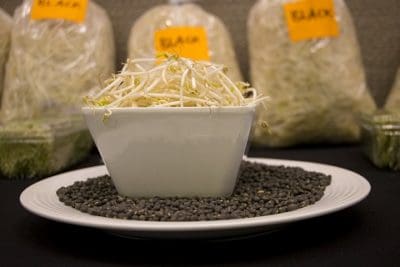HIGH prices for mungbeans over the last two years have caused increased production within many of the countries that are traditional markets for Australian product. As a result of increased supply, a correction in price for green mungbean has recently been experienced.

The latest release black gram variety, Onyx-AU, is well-suited to sprout production. Around the world mungbeans are treated more as a vegetable than a grain, making hygienic practice essential throughout production, processing and storage.
This correction in price is likely to see reduced production in some countries, which could easily change the world supply and demand position.
Production in Myanmar is forecast to be down to 170,000 tonnes, almost half of their production last year, opening up opportunities in Australia’s traditional Asian markets.
In June, India introduced an import restriction of 300,000t of mungbeans per fiscal year (starting on April 1 each year). However, Australia is in a good position to be the preferred supplier for the Indian quota.
Australian Choice Exports’ James Hunt is confident that prices will hold up, with demand looking good and prices stable.
Stocks of the 2016–17 crop have been sold and with very little spring crop planted, demand is expected to be strong on world markets when the Australian crop is harvested in March through to June.
Demand is usually strongest during the Australian harvest period and can drop off slightly as other countries begin their harvest seasons.
By working closely with an AMA member or marketer, growers can reduce their marketing risk and get the best value possible for their mungbean crop.
Variety selection
The large shiny green mungbean varieties such as Jade-AU and Crystal have taken Australia onto the world stage and will continue to dominate the Australian industry, providing high yield and reduced production risk.
AMA president Mark Schmidt said while most growers were familiar with these varieties, opportunities also existed for growing specialty mungbean varieties such as Celera II-AU, Satin II and the new black gram, Onyx-AU.
Celera II-AU is a small seeded variety that normally receives a premium over the large seeded varieties and has the best resistance to halo blight out of all current varieties.
Satin II is the preferred sprouting variety with established local and export markets. There is strong demand for high quality product meeting sprouters’ specifications.
Black gram varieties Regur and Onyx-AU are well sought after in a whole range of markets from sprouting to processing for dhal. Onyx-AU has a yield advantage over Regur and is a direct replacement for this older variety.
As with all niche crops it is important to consult with your marketer prior to planting and establish the market requirements.
Source: AMA www.mungbean.org.au

HAVE YOUR SAY